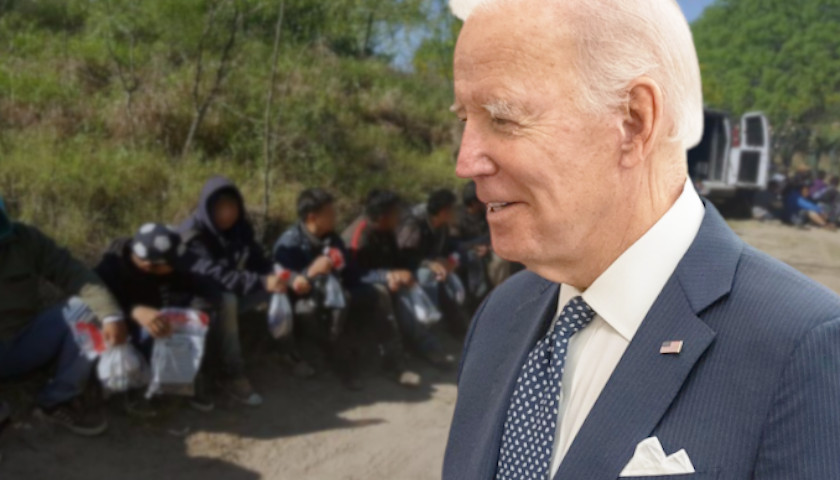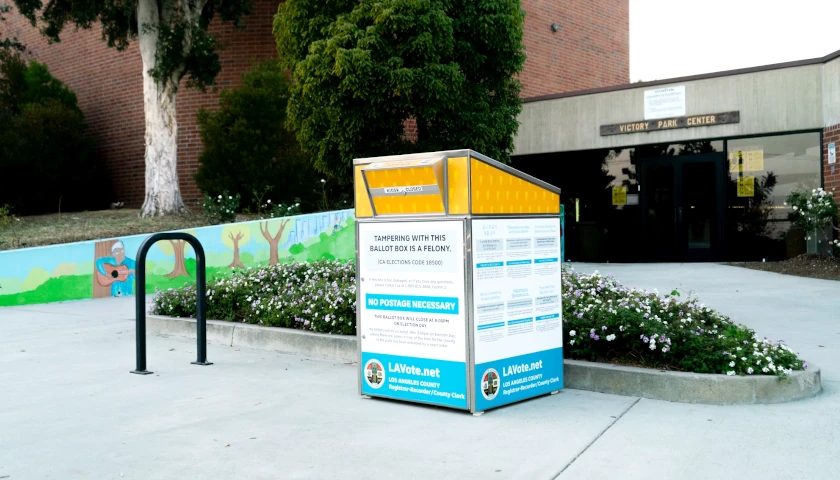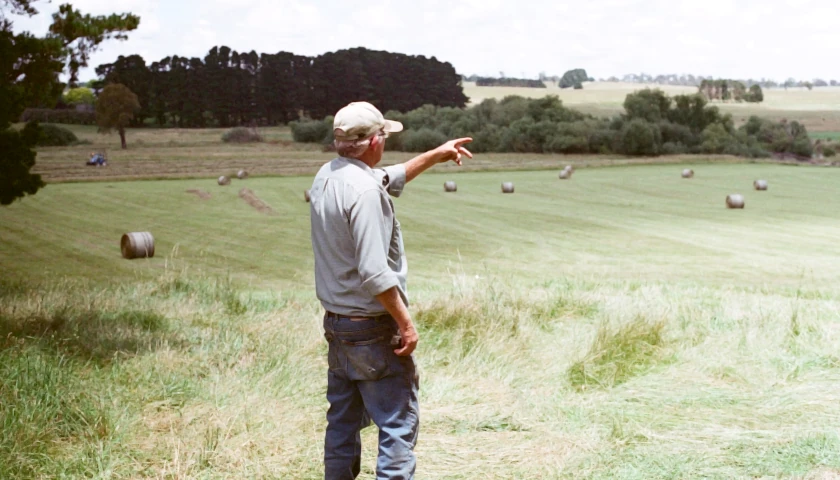by James Varney
When Vice President Kamala Harris visited Mexico last year, she cited poverty, crime, and political instability as “root causes” driving millions of migrants to cross the U.S. border.
But some critics with regional expertise say Biden administration policies, which migrants have interpreted as an invitation to travel north, have severely worsened those root causes, destabilizing large swaths of Central America and Mexico. The torrent of people moving across the region has delivered billions of dollars to the coffers of human smuggling rings and the drug cartels that have taken advantage of America’s overwhelmed border patrol to deliver fentanyl and other deadly substances to the United States.
Criminal organizations, these experts say, have stoked rampant corruption, especially in Mexico, as they pay bribes to police and other local officials to ease passage of their cargo. The migrants themselves are prey to gangster elements that, according to one account, leaves more than two-thirds of them victims of crime and nearly one-third of the women subjected to sexual assaults.
“Mexico is probably one of the most dangerous places for the transit of migrants,” said Dr. Juan Luis Hernandez Avendano, rector of the Ibero-American University of Torreon-Monterrey-Saltillo, who has been an outspoken critic of the surging corruption in his country.
“And despite this, the routes to enter the United States continue to be fed not only by Central Americans, but increasingly by Caribbeans, and according to reports from the Jesuit Migrant Service, more Asians and Africans,” Avendano told RealClearInvestigations. “In effect, we are experiencing a humanitarian crisis, since they are not only extorted by the cartels, but also subjected to labor and sexual slavery. It has gotten worse because Venezuelan migration has joined” the human tide.
Avendano has been sharply critical of the situation for years, going so far this year as to declare swaths of Mexico “failed states” for the inability of authorities to protect native Mexicans and illegal immigrants, and the increasing corruption and unreliability of federal forces and local authorities.
While much attention in the United States has focused on the problem caused by migrants at the border, Avendano is part of a growing chorus of people who say the Biden administration’s policies are exacerbating problems to the south. The White House did not respond to requests for comment.
The illegal immigration surge shows no signs of abating, although on Oct. 12 the administration quietly reinstituted so-called Title 42 measures that have blocked entrance for many Venezuelans. Another monthly record for encounters was shattered in September, according to figures released by the Department of Homeland Security, and the 227,000 total for that month was 11% higher than the figure for August.
Encounters with illegal immigrants are up 37% in 2022 from 2021, and to date more than 3 million have crossed into the U.S. since Biden’s inauguration. To put that number in perspective, the total number of illegal immigrants under Biden would top Chicago’s population to become the 3rd largest city in the U.S. The border crossers would constitute the union’s 34th largest state, exceeding the population of Mississippi and nearly equaling that of Arkansas.
Although the administration has claimed that the border is secure and that it has told migrants not to come to America, it has instituted many policies they see as welcoming. This began on President Biden’s first day in office, when he declared that no one would be deported for 100 days.
These policies have helped empower criminal elements. The fees paid to smugglers by this human flood have put an additional $2.6 billion into Mexican criminal cartel coffers in the past 12 months, according to an October analysis by the Washington Times. The profits have risen along with the price, as immigrants now pay roughly $8,600 in smuggling fees if they start their odyssey in Mexico, while those starting farther south can pay $11,500 or more. And those figures do not include transportation fees or bribes immigrants must pay to cross various borders across the Central American isthmus.
Most recently, the route to the U.S. for tens of thousands of illegal immigrants begins in Venezuela, a country rich in oil and natural resources but impoverished by more than two decades under the governance of a socialist military dictatorship.
The trip from Caracas, the capital, to San Diego is more than 3,500 miles, an overland odyssey that crosses  at least six countries and at its beginning entails traveling through the Darien Gap that joins Central with South America, considered one of the most untamed spots on earth. While Venezuela’s crime rate was the world’s highest in 2021, people fleeing to the U.S. must still pass through violent lands in Honduras (ranked fifth in the world in crime last year, according to the World Population Review) and El Salvador (ranked eighth).
Today thousands of Venezuelans just beginning the trek occupy makeshift camps along streets in San Jose, Costa Rica’s capital, with flags proclaiming their home country and signs begging for money and food.
“It’s shocking – there are families on the streets here with kids,” said Roberto Leiton, a U.S.-based businessman with operations in Costa Rica. “There’s thousands of them; my wife was crying as we drove by and we went to the supermarket to get bags of food. But they have no money, they’re going to have to steal – something is going to happen.”
Just how countries north of Costa Rica are coping with the human rivers transiting them can be difficult to gauge.
President Alejandro Giammattei of Guatemala, for one, has publicly blamed the Biden administration for doing little to address the problem, saying last month in an interview with the Daily Caller Foundation that it has “refused to provide the tools to deport illegal immigrants heading to the U.S.”
To be sure, these Central American nations do receive some benefits from this migration as migrants send money back home from the United States. Remittances hit an all-time high in 2021, rising 27% to Mexico and 29.4% throughout Central America, according to Inter-American Development Bank. That represented 28% of the economy in Honduras, for example.
Not everyone familiar with the situation thinks the massive increase in illegal immigration spells worse conditions for those making the arduous trek. In some cases, the increase has made the process more purely transactional for groups profiting handsomely from the torrent and thus, oddly, made it safer.
“Things have changed a lot and the violence has been transformed,” said Guadelupe Correa-Cabrera, a professor at George Mason University who researches border issues and has written about the Zetas, the defunct Mexican criminal organization that infamously massacred some 300 people in Allende in 2011.
“Kidnapping is still an issue, but I have not heard the stories I heard in previous years and I don’t think they are doing now what they did four or five years ago,” Correa-Cabrera said. “Some rapes and violence have continued but not the shocking bloodshed we saw previously.”
As recently as last July, however, non-governmental organizations and individuals concerned about the situation throughout Central America were decrying what Doctors Without Borders first described as “a humanitarian crisis” in a 2017 report. That report, derived from verbal questionnaires the group did with illegal immigrants at its Mexico treatment stations, concluded that more than two-thirds of those making the trek had been victimized by criminals and nearly one-third of the women had been sexually assaulted. Doctors Without Borders declined to speak with RealClearInvestigations.
On July 11,  nearly 90 NGOs and individuals signed a letter to Biden and Mexican President Andrés Manuel López Obrador in which they outlined dire circumstances. In addition to the 53 illegal immigrants found dead in a truck outside San Antonio last summer, the groups described another smuggling disaster in Chiapas, Mexico, fatal to 55 people in December 2021 – also a result of overcrowding.
The letter cited more than 10,000 cases of “kidnapping and other brutal attacks” in Mexico, where since 2020 “organizations have documented deeply concerning incidents of members of Mexico’s National Guard and the National Migration Institute (INM) beating Black migrants, separating families, and utilizing excessive force towards migrants along Mexico’s southern border.”
The solutions proposed in the letter were more streamlined and open border policies, as “enforcement-centric policies fuel violence and attacks towards migrants, increase humanitarian crises at our borders, and enable smugglers and traffickers to prey on migrants,” according to the letter.
RCI reached out to more than a dozen signatories to the letter, but only the Washington Office on Latin America responded. In July, it produced a report on deplorable conditions for immigrants in Tapachula, Mexico, near the border with Guatemala. A humanitarian crisis is unfolding there in what immigrants dub a “prison city,” according to Stephanie Brewer, WOLA’s director for Mexico and an author of the report.
“You can try to stop it or move it around, but that simply leads to a dip or a reconfiguration of the migration routes,” Brewer said.
U.S. taxpayers have contributed to aid programs for immigrants in Mexico, contributing more than $38.7 million, or 77%, of the United Nations High Commissioner for Refugees budget in that country in 2021. Despite such contributions, Brewer echoed Vice President Harris’ view in pointing to “root causes,” arguing that those moving toward the U.S. are driven by the crime-riddled and poverty-stricken pockets of their native Latin American countries. “The push factors outweigh the pull factors in the decision to leave,” she said.
Nevertheless, such attention has yielded no dividends. That is evident not only in the ever-increasing numbers of illegal immigrants pouring across the southern border but in Central American capitals, too.
Todd Bensman, who for two years has reported from various hotspots along Central American immigration caravan routes for the conservative Center for Immigration Studies, said he always asks immigrants what they have seen along the way. The images they show him on their phones – of corpses, some of them of pregnant women clutching their dead infants – has convinced him the surge in traffic is something close to an international crime.
“There’s most definitely a lot of blood on the hands of the Biden administration for opening the Southern border on purpose, and not to know what will happen and then how to deal with it,” Bensman told RCI. “Untold numbers of people are dead.”
– – –
James Varney is a writer for RealClearInvestigations.
Photo “Joe Biden” by Joe Biden.




